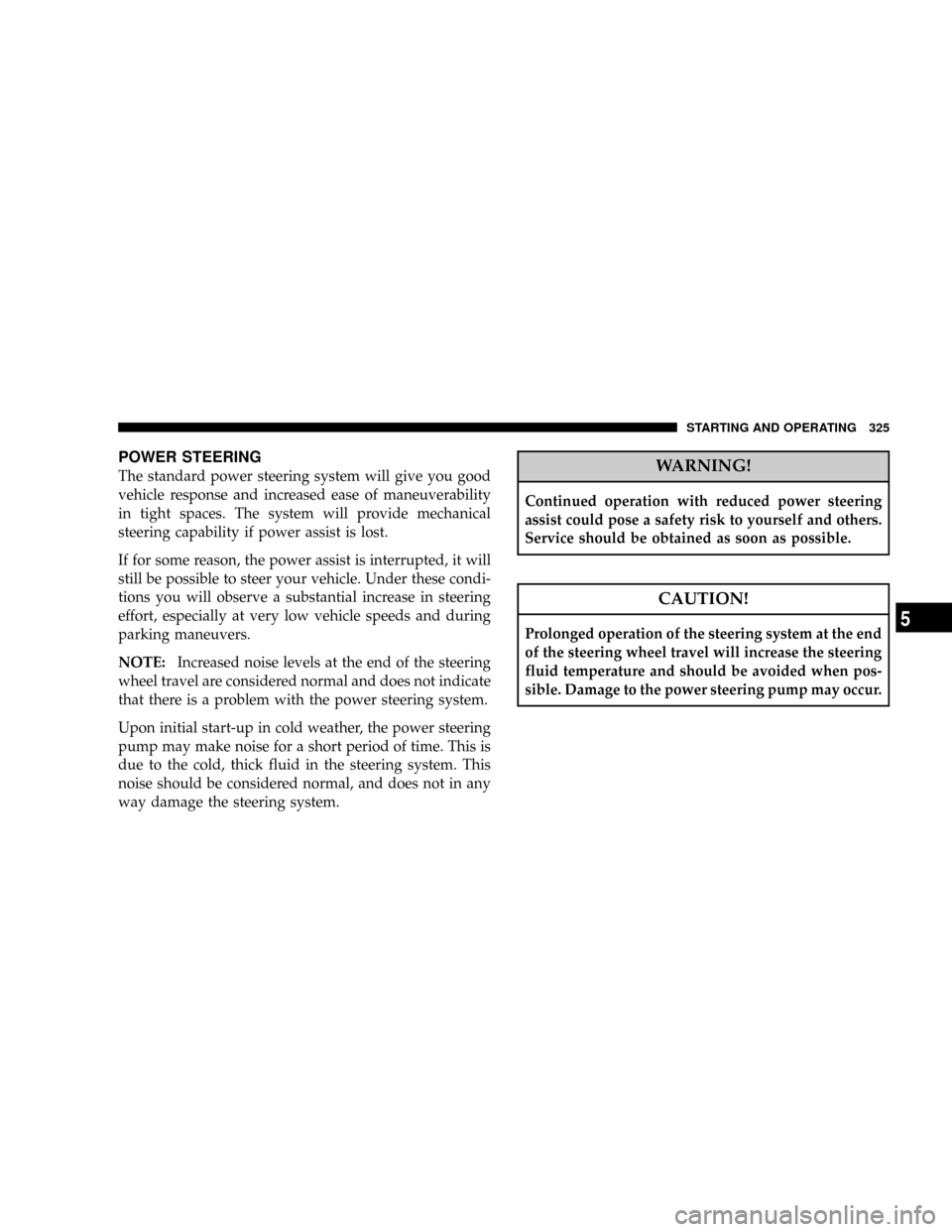Page 291 of 504

CAUTION!
Winching or rocking the vehicle off hard objects
increases the risk of underbody damage.
Hill Climbing
Hill climbing requires good judgment and a good under-
standing of your abilities and your vehicle's limitations.
Hills can cause serious problems. Some are just too steep
to climb and should not be attempted. You should always
feel confident with the vehicle and your abilities. You
should always climb hills straight up and down. Never
attempt to climb a hill on an angle.
²Before Climbing A Steep Hill± As you approach a
hill consider its grade or steepness. Determine if it is
too steep. Look to see what the traction is on the hill
side trail. Is the trail straight up and down? What is on
top and the other side? Are there ruts, rocks, branchesor other obstacles on the path? Can you safely recover
the vehicle if something goes wrong? If everything
looks good and you feel confident, then change trans-
mission into a lower gear, shift the transfer case into 4L
(Low) and proceed with caution. You should use first
gear and 4L (Low) for very steep hills.
²Driving Up Hill± Once you have determined your
ability to proceed and have shifted into the appropri-
ate gear, line your vehicle up for the straightest
possible run. Accelerate with an easy constant throttle
and apply more power as you start up the hill. Do not
race forward into a steep grade, the abrupt change of
grade could cause you to lose control. If the front end
begins to bounce, ease off the throttle slightly to bring
all four tires back on the ground. As you approach the
crest of the hill ease off the throttle and slowly proceed
over the top. If the wheels start to slip as you approach
the crest of a hill, ease off the accelerator and maintain
headway by turning the steering wheel no more than
STARTING AND OPERATING 291
5
Page 325 of 504

POWER STEERING
The standard power steering system will give you good
vehicle response and increased ease of maneuverability
in tight spaces. The system will provide mechanical
steering capability if power assist is lost.
If for some reason, the power assist is interrupted, it will
still be possible to steer your vehicle. Under these condi-
tions you will observe a substantial increase in steering
effort, especially at very low vehicle speeds and during
parking maneuvers.
NOTE:Increased noise levels at the end of the steering
wheel travel are considered normal and does not indicate
that there is a problem with the power steering system.
Upon initial start-up in cold weather, the power steering
pump may make noise for a short period of time. This is
due to the cold, thick fluid in the steering system. This
noise should be considered normal, and does not in any
way damage the steering system.WARNING!
Continued operation with reduced power steering
assist could pose a safety risk to yourself and others.
Service should be obtained as soon as possible.
CAUTION!
Prolonged operation of the steering system at the end
of the steering wheel travel will increase the steering
fluid temperature and should be avoided when pos-
sible. Damage to the power steering pump may occur.
STARTING AND OPERATING 325
5
Page 406 of 504

NPower Steering Ð Fluid Check............421
NFront Suspension Ball Joints..............422
NSteering Linkage Ð Inspection............423
NFront Prop Shaft Lubrication.............423
NBody Lubrication.....................424
NWindshield Wiper Blades................424
NWindshield Washers...................424
NExhaust System......................425
NCooling System.......................426
NHoses And Vacuum/Vapor Harnesses.......431
NBrake System........................432
NClutch Hydraulic System................433
NClutch Linkage.......................433NRear Axle And 4X4 Front Driving Axle Fluid
Level..............................434
NTransfer Case........................435
NFront Drive Shaft.....................435
NManual Transmission..................435
NAutomatic Transmission................436
NFront Wheel Bearings..................439
NNoise Control System Required Maintenance &
Warranty...........................439
NAppearance Care And Protection From
Corrosion...........................443
mFuses (Integrated Power Module)...........447
mVehicle Storage........................452
mReplacement Light Bulbs.................453
406 MAINTAINING YOUR VEHICLE
Page 421 of 504

include cleaning of the condenser fins and a performance
test. Drive belt tension should also be checked at this
time.
WARNING!
²Use only refrigerants and compressor lubricants
approved by the manufacturer for your air condi-
tioning system. Some unapproved refrigerants are
flammable and can explode, injuring you. Other
unapproved refrigerants or lubricants can cause
the system to fail, requiring costly repairs.
²The air conditioning system contains refrigerant
under high pressure. To avoid risk of personal
injury or damage to the system, adding refrigerant
or any repair requiring lines to be disconnected
should be done by an experienced repairman.
Refrigerant Recovery and Recycling
R-134a Air Conditioning Refrigerant is a hydrofluorocar-
bon (HFC) that is endorsed by the Environmental Pro-
tection Agency and is an ozone-saving product. How-
ever, the manufacturer recommends that air conditioning
service be performed by dealers or other service facilities
using recovery and recycling equipment.
NOTE:Use only manufacturer approved A/C System
Sealers, Stop Leak Products, Seal Conditioners, Compres-
sor Oil, or Refrigerants.
Power Steering Ð Fluid Check
Checking the power steering fluid level at a defined
service interval is not required. The fluid should only be
checked if a leak is suspected, abnormal noises are
apparent, and/or the system is not functioning as antici-
pated. Coordinate inspection efforts through a certified
DaimlerChrysler Dealership.9
MAINTAINING YOUR VEHICLE 421
7
Page 422 of 504

WARNING!
Fluid level should be checked on a level surface and
with the engine off to prevent injury from moving
parts and to insure accurate fluid level reading. Do
not overfill. Use only manufacturers recommended
power steering fluid.
If necessary, add fluid to restore to the proper indicated
level. With a clean cloth, wipe any spilled fluid from all
surfaces. Refer to Fluids, Lubricants, and Genuine Parts
for correct fluid type.
Front Suspension Ball Joints
NOTE:When anticipating any severe offroad or hill
climbing maneuvers, the power steering fluid level may
be increased to the FULL HOT level (with a cold system).
In this way, the power steering system will continue toprovide assist as the inclination angle of the vehicle
increases, i.e. when the vehicle is not on level ground.
NOTE:When anticipating any severe offroad/dusty or
wet conditions, ensure that the outer tie rod ends are
properly greased before ans soon after the vehicle is
taken through such conditions. The greasing will help
purge contaminants and water from under the seal.
Regular greasing will prolong the life of the ball joints.
The ball joints and seals should be inspected whenever
the vehicle is serviced for other reasons.
The ball joints originally supplied with the vehicle are
permanently lubricated at the factory and do not require
service. However, if the seals on the ball joints are
damaged, the joints should be replaced. Serviceable
replacement ball joints are available.
422 MAINTAINING YOUR VEHICLE
Page 450 of 504
Cavity Cartridge
FuseMini
FuseDescription
27 40 Amp
GreenPower Seats
28 10 Amp
RedPower Run/Start-
PCM/Steering Angle
Sensor
29 10 Amp
Red4X4 Switch/Pass Dr
Switch/EC Mirror
30 15 Amp
BluePower Run/Start-
ABS/RWAL/Smart
Bar/YAW Sensor/
Universal Exhaust
Gas Oxygen (Uego)
Sensor Controller
31 10 Amp
RedPCM (Gas)/TCM
(Diesel 58RFE)Cavity Cartridge
FuseMini
FuseDescription
32 10 Amp
RedPower Ignition Run
Ð Adjustable Pedals
LED
33 10 Amp
RedPower-IGN Run Ð
HVAC
34 Ð Ð
35 15 Amp
BlueCabin Compartment
Node (CCN) Illumi-
nation
36 25 Amp
NaturalAudio_Amplifier
37 15 Amp
BlueVariable Gate Turbo
(VGT) Ð Turbo Die-
sel
38 20 Amp
YellowPower Outlet IP
450 MAINTAINING YOUR VEHICLE
Page 466 of 504
Chassis
Component Fluids, Lubricants and Genuine Parts.
Automatic Transmission MopartATF+4, Automatic Transmission Fluid
Transfer Case MopartATF+4, Automatic Transmission Fluid
Manual Transmission Fluid (G-56) MopartATF+4, Automatic Transmission Fluid
Front Driveshaft Grease Fitting. Use Moparttype MS-6560 (lithium based grease), or equivalent.
Clutch Linkage Multipurpose Grease, NLGI Grade 2 E.P.
Front and Rear Axle Synthetic, GL-5 SAE, 75W-90. Limited-Slip 10.5 inch Rear AxleLimited
slip additive is not required.
Brake Master Cylinder MopartDOT 3 and SAE J1703 should be used. If DOT 3 brake fluid is not
available, then DOT 4 is acceptable. Use only recommended brake fluids.
Power Steering Reservoir MopartATF+4, Automatic Transmission Fluid
466 MAINTAINING YOUR VEHICLE
Page 469 of 504

²Change your engine oil more often if you drive your
vehicle off-road for an extended period of time.
²Under no circumstances should oil change intervals
exceed 6,000 miles (10,000 km) or 6 months, whichever
comes first.
Your dealer will reset the oil change indicator message
after completing the scheduled oil change. If this sched-
uled oil change is performed by someone other than your
dealer the message can be reset by referring to the steps
described under ªOdometer/Trip Odometerº under ªIn-
strument Cluster Descriptionº in Section 4 of this
manual.
At Each Stop for Fuel
²Check the engine oil level about 5 minutes after a fully
warmed engine is shut off. Checking the oil level whilethe vehicle is on level ground will improve the accu-
racy of the oil level reading. Add oil only when the
level is at or below the ADD or MIN mark.
²Check the windshield washer solvent and add if
required.
Once a Month
²Check tire pressure and look for unusual wear or
damage.
²Inspect the battery and clean and tighten the terminals
as required.
²Check the fluid levels of coolant reservoir, brake
master cylinder, power steering and transmission and
add as needed.
²Check all lights and other electrical items for correct
operation.
MAINTENANCE SCHEDULES 469
8
M
A
I
N
T
E
N
A
N
C
E
S
C
H
E
D
U
L
E
S